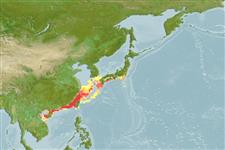Classification / Names
Common names | Synonyms | Catalog of Fishes(genus, species) | ITIS | CoL | WoRMS | Cloffa
Teleostei (teleosts) >
Gobiiformes (Gobies) >
Gobiidae (Gobies) > Gobiinae
Etymology: Tryssogobius: Greek, tryo, tryso = to wear away + see under Gobius; porosus: Named for its preopercular pores and those over the opercle, the main distinguishing feature of the species.
More on authors: Larson & Chen.
Environment: milieu / climate zone / depth range / distribution range
Ecology
Marine; benthopelagic; depth range 18 - 100 m (Ref. 58420). Temperate
Distribution
Countries | FAO areas | Ecosystems | Occurrences | Point map | Introductions | Faunafri
Northwest Pacific: China and Taiwan.
Size / Weight / Age
Maturity: Lm ? range ? - ? cm
Max length : 2.8 cm SL male/unsexed; (Ref. 58420); 2.6 cm SL (female)
Short description
Identification keys | Morphology | Morphometrics
Dorsal spines (total): 7; Dorsal soft rays (total): 9; Anal spines: 1; Anal soft rays: 10; Vertebrae: 26. This species is distinguished by the following characters: preopercular canal with 3 pores and 2 pores over opercle; color in life translucent with yellow markings on the body and fins, with a distinctive dense black oval blotch posteriorly on first dorsal fin; 5th -8th caudal fin rays usually elongate and filamentous, extending beyond other rays; branchiostegal membranes with one cycloid scale on each side; second dorsal fin I, 9; anal fins I, 10; pectoral fin rays 20-21 (Ref. 58420).
Specimens trawled from muddy substrate (Ref. 58420).
Life cycle and mating behavior
Maturity | Reproduction | Spawning | Eggs | Fecundity | Larvae
Larson, H.K. and I.-S. Chen, 2007. A new species of Tryssogobius (Teleostei, Gobiidae) from Hianan Island, China and Taiwan. Zool. Stud. 46(2):155-161. (Ref. 58420)
IUCN Red List Status (Ref. 130435: Version 2024-2)
Threat to humans
Harmless
Human uses
Fisheries: bycatch
Tools
Special reports
Download XML
Internet sources
Estimates based on models
Preferred temperature (Ref.
123201): 21.9 - 25.1, mean 23.7 °C (based on 29 cells).
Phylogenetic diversity index (Ref.
82804): PD
50 = 0.5078 [Uniqueness, from 0.5 = low to 2.0 = high].
Bayesian length-weight: a=0.01023 (0.00477 - 0.02194), b=3.01 (2.83 - 3.19), in cm total length, based on LWR estimates for this (Sub)family-body shape (Ref.
93245).
Trophic level (Ref.
69278): 3.1 ±0.3 se; based on size and trophs of closest relatives
Resilience (Ref.
120179): High, minimum population doubling time less than 15 months (Preliminary K or Fecundity.).
Fishing Vulnerability (Ref.
59153): Low vulnerability (10 of 100).
